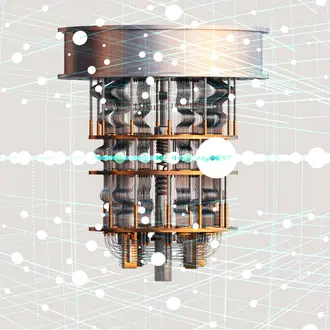Credit: tiero / iStock
Commodity businesses live or die based on operational efficiency. Since the market treats commodities as interchangeable, regardless of who produces them, companies must compete on their ability to produce more for less.
And commodity markets aren’t limited to basic resources like grains, metals, or energy products. Even complex machinery and equipment can be commoditized in a global competitive market.
Epiroc, a manufacturer of mining, drilling, and construction equipment, has innovated in its long-established industry by identifying needs ranging from digital services to electrified mining vehicles and giant robotic drilling rigs that can be controlled from hundreds of miles away. These large, expensive machines are complex, and the competition is global, sophisticated, and aggressive.
It’s only by understanding the needs of its customers and developing new complementary innovations that Epiroc has been able to differentiate itself, said Jon Torpy, the president and general manager of Epiroc USA. “Going back a decade and then looking forward a decade, you try to anticipate the challenges and decide, ‘How are we going to continue to be a solutions provider as that evolution takes place?’” he said.
In a recent MIT Executive Education webinar with MIT Sloan senior lecturer Torpy discussed how Epiroc has spurred innovation, including creating a program to empower product managers to explore new products and services that complement existing products, add value for customers, and generate new sources of revenue for Epiroc.
Moving beyond selling “dumb iron”
Torpy described Epiroc as a four-year-old company founded in 1873. Atlas Copco, a 150-year-old Swedish company, owned Epiroc until it was split off as a separate company in 2018. Torpy has been with the company since 1999.
Epiroc sells equipment to some of the world’s biggest mining companies. To stay relevant, the company has incorporated robotics and automation into its products. One of its recent innovations is remote automation for 150-ton drills operating deep inside a copper mine. “They’re robots. They’re given a set of instructions, and they operate for 12 to 24 hours at a time without human interaction,” Torpy said. “The operator is remote — in some cases, more than 1,000 miles away.”
Automation has clear benefits for human safety. It also allows Epiroc to transition from individual sales of heavy machinery to ongoing partnerships with mining companies.
“As an equipment manufacturer, we’re not going to be around 140 years [from now], at the profitability levels that we expect, if we just build and sell ‘dumb iron,’” Torpy said. “We needed to change how we’re perceived — to show that we can be a robotics company, that we can be a company that understands data and what to do with it, and that we can identify opportunities for digitalization.”
Making product managers the CEOs of their products
Yet Epiroc can never forget that “dumb iron” — expensive machinery — is the core of Epiroc’s business, Torpy said. They need to center their innovation efforts not just on making these products better, but adding new products and services around them.
To do this, the company developed a product owner excellence program, which encouraged employees in product or portfolio management roles to “act like you’re the CEO of your product,” as Torpy put it. “The closest people to the problem are the best ones to solve it,” he said. (It helps that Epiroc already had a decentralized structure, he added.)
As one example, Torpy recalled a conversation with a colleague who completed the product owner program. They were standing in Epiroc’s booth at a trade show, and the colleague took Torpy on a tour of a redesigned undercarriage for a mining bulldozer.
At initial glance, the machine looked ordinary. But the product team had reconfigured the undercarriage to support an autonomous drill without having to change the track system on which the drilling rig moves.
“Because of this program, people are coming up with a better way to do things without over-complicating it,” Torpy said. “The people who come out of the program are really energized to work this way.”
Innovating “around the box”
Robertson, who leads an executive education course about innovating in existing markets, has previously described this approach as innovating around the box: creating complementary services and experiences around core product offerings. LEGO, for example, has generated growth and profits in its business not by revolutionary, disruptive innovation, but by creating events, games, TV shows, theme parks, and feature length movies that encourage kids (and adults) to play with their core brick-basted construction sets.
Related Articles
Innovating around the box is different than innovating outside the box — exploring disruptive, revolutionary innovations that are expensive, risky, and difficult, Robertson said.
Companies that stay inside the box, on the other hand, risk being caught by their competitors and commoditized. One symptom of a focus on “inside the box” innovation is a proliferation of similar products, which Torpy referred to as the “disease of more.”
“The idea is, ‘This drill was great. Let’s build another drill that’s like that, but slightly bigger, and then another drill that’s like that, but slightly smaller. And then let’s build another one that’s like that, but yellow,’” he said. In other words, manufacturing essentially the same product over and over, increasing costs but providing little benefit to customers and not generating any growth.
Understanding the financial impact of product decisions
The primary benefit of innovating around the box is the ability to bring innovation — automation, remote control, data analytics — to products that customers already know and love. The challenge is that changes to an existing product can impact the bottom line in a way that product teams may not realize.
That’s why financial knowledge is a core piece of the product owner excellence program. The goal is for anyone who’s a product CEO, regardless of educational or professional background, to understand the ins and outs of a profit and loss statement and how product modifications or improvements impact other parts of the business.
“Understanding the consequences of technical decisions is really important. We can develop great things all day long, but if they cost a lot and don't make us money, or if we don't think about the business model proactively, they're not sustainable,” he said. “If you make decisions and totally ignore the [profits and losses], it can be a pretty big path to going broke. If we do the right thing for Epiroc, then the KPIs all fall into place.”
Explore the course: Innovating in Existing Markets: Reviving Mature Products and Services



